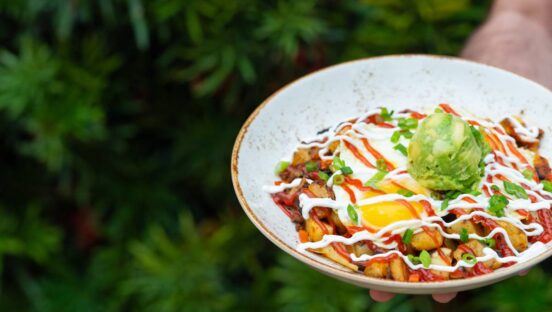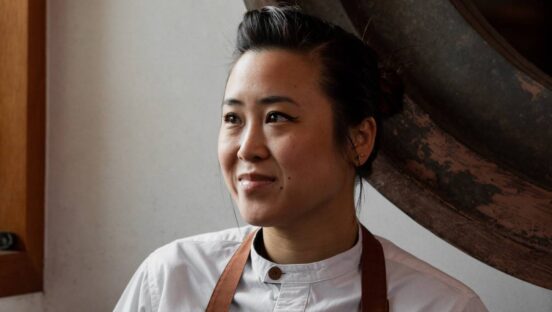





Contains paid advertising content from American Express.
Every year, icons of the culinary world ascend the Rocky Mountains on their way to the FOOD & WINE Classic in Aspen, Colorado. During this three-day event, attendees immerse themselves in the world of food, restaurants, and wine. They learn from seminars and cooking demonstrations, taste wines and unique dishes, attend parties, and take part in the 30th annual Restaurant Trade Program, sponsored by American Express.
This year, FSR editor Nicole Duncan attended Aspen’s FOOD & WINE Classic. Check out the top 5 things we learned at the event, and how you can use these lessons to help grow your restaurant business.
Though the celebrity chef sightings and cooking demonstrations tend to be the first things people think of with respect to Aspen’s FOOD & WINE Classic, the marquee event also features robust offerings designed to support the restaurant industry. One such opportunity is American Express’ annual Restaurant Trade Program, which is a can’t-miss for those looking to connect and discuss the most important and relevant topics in the dining industry today.
Dedicated to uniting the chefs, restaurant operators, and industry professionals who shape the world of dining, the Restaurant Trade Program is a fascinating three-day program featuring networking events and dynamic panel discussions. This year’s program focused on how industry professionals can find long-term success and some of the most pressing challenges facing the industry, such as increasing diversity and incorporating new technologies that are redefining the dining experience.
American Express’ Restaurant Trade Program has actually been a staple of Aspen’s FOOD & WINE Classic for 30 years. The company has long been committed to backing growth and innovation in the dining industry, with the number of American Express-accepting restaurants continuing to grow—in fact, more than 114,000 new U.S. restaurants began accepting American Express in 2018 based on internal data comparing the number of American Express small merchant locations from December 2017 to December 2018.
According to Gunther Bright, executive vice president, Merchant Services—U.S. at American Express, “We consider the Restaurant Trade Program to be a highly integral part of American Express’ continued efforts to support the dining industry. For the past 30 years, we’ve been proud to provide this unique opportunity for chefs and restaurateurs to learn and share insights that can collectively drive the health and innovation of this industry.”
In recent years, foodservice—like every other industry—has become highly focused on the idea of innovation. Restaurants understand that as competition for guests heats up and as restaurants face growing labor costs, it’s crucial that they find ways to innovate on the menu and in operations. But innovation can be a challenge. This is what participants in “The Future of the Restaurant Industry” panel debated.
Christina Tosi, founder of Milk Bar, said that she’s come to dislike the word “innovate” because it also carries a connotation of perfection or almost cool detachment that seems opposed to the industry’s nature. Hospitality, more so than most sectors, relies on the human touch and tradition. She said that she aspires to be “perfectly imperfect and comfortably human.”
In a one-on-one conversation with FSR’s editor, chef Tracy Des Jardins discussed how excited she is to work with Impossible Foods—a company working to create plant-based burgers that taste and feel like meat—and see a direct impact, but she also recognizes that as a Bay Area resident, innovation and tech can sometimes overpower creativity.
Other restaurateurs and chefs who spoke at the event were all hopeful that innovation, when done right, could continue to enhance the best parts of restaurants. While restaurants must innovate, this forward momentum must be balanced to keep the overall restaurant experience front and center.
With such fierce competition for customers today, it’s no wonder so many restaurants are focused on creating innovative concepts. The challenge, however, is that sometimes this focus on creating something new and different doesn’t translate into an engaging experience. Often, taking a step back to the basics can help clarify what a restaurant’s theme should be. The easiest way to do this is to think about the type of restaurant you’d want to visit.
Will Guidara of Make It Nice Hospitality said in a one-on-one conversation that while consumer sentiment is certainly important in guiding a business, entrepreneurs must build the restaurants they would personally dine in and frequent. For him, Eleven Madison Park is a place for special celebrations—or even one where the food is the celebration. The NoMad restaurants are funky, eclectic spaces that are ideally suited for drinks and good bites, while Made Nice is the kind of sandwich shop you could frequent every day.
Similarly, Michael Farid, co-founder and CEO of Spyce Food Co. explained in “The Future of the Restaurant Industry” panel that he was an MIT grad student in robotics when he first came up with the idea of an automated restaurant. On a shoe-string budget, he bemoaned the high food prices with a chef friend, who in turn inspired him to build a robot that could make stir-fry with the quality ingredients he wanted, and at the lower price point he wanted to provide his customers.
There is no question that inclusivity will become increasingly critical as many major brands focus on providing opportunities to communities that may not otherwise have a voice in the restaurant industry, and we are likely to see more inclusivity-focused brands in the future.
For example, Hot Bread Kitchen is a decade-old nonprofit that is helping bring more women (specifically immigrant women) into the foodservice fold. Oftentimes these women have knowledge and recipes that even learned chefs do not, but in the past language barriers and other obstacles have made it difficult for them to share these gifts and support themselves professionally. Hot Bread provides culinary training and serves as an incubator for aspiring entrepreneurs who may not otherwise have the means to jumpstart their business and test proof of concept.
Similarly, La Cocina (on which Traci Des Jardins sits as a board member) provides commercial kitchen space in a supportive community with mentorship opportunities. It addresses inequities in business ownership by targeting women, people of color, and minorities.
We learned that dining is an integral part of U.S. American Express Card Members’ lives per recent data, making this audience highly valuable. According to a recent study, American Express Card Members who had made purchases at restaurants in the prior three months reported they spent an average of 90 percent more at restaurants than Non-Card Members and dined an average of 20 percent more times than Non-Card Members.
They’re also loyal—63 percent of Card Members reported that when thinking specifically about paying for restaurant purchases with American Express, they agree they are more likely to return to a restaurant when they know it accepts American Express. 54 percent reported they are more likely to make a purchase at a restaurant if they saw an indication that American Express was accepted at that restaurant on the front door or window.
In short, the spending habits and loyalty of American Express Card Members may help restaurants drive sales, making it wise to consider accepting payment by American Express. Learn more about it here.











